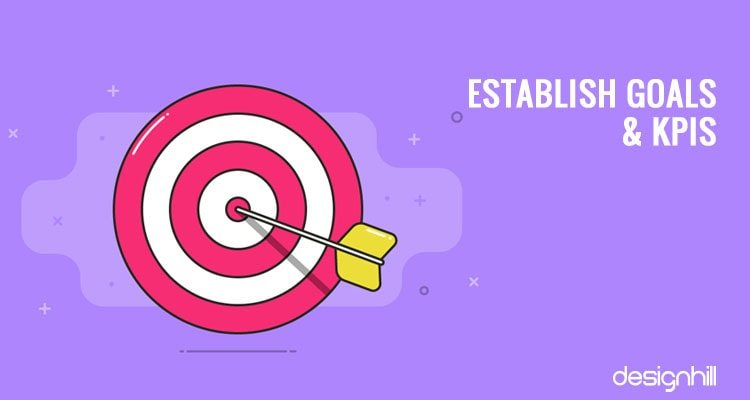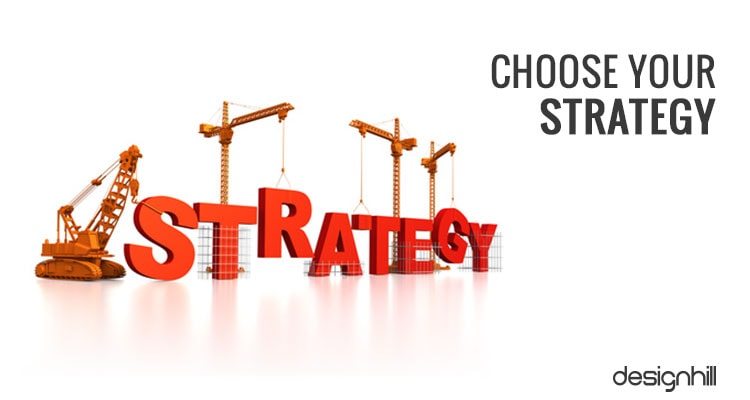Last updated on February 7th, 2023
To improve the effectiveness of your b2b marketing efforts, you need to have a well-defined strategy in place. These business promotion strategies will decide whether your business will fly high or takes a nosedive.
Let’s state the obvious, there are fundamental differences between B2C marketing and B2B marketing. Each approach requires a specific skill set, strategy, and general outlook. Today we’re focusing solely on the B2B universe.
Here Are 5 Business Promotion Methods For A B2B Organization
01. Establish Goals & KPIs
Before you begin to promote your B2B organization, it’s important to understand what your end goal is. This will often differ from organization to organization — ranging from brand awareness, to lead generation, to revenue. For the sake of consistency, we’ll be referring to lead generation as our goal throughout the post.

Next, you should determine your KPIs (key performance indicators), or campaign milestones to track your progress. These metrics will help you analyze the success of your promotional efforts and scale your campaigns as needed.
Looking For a Logo Design?
We have helped thousands of business owners from all around the world with their graphic design needs such as logo design, website design, social media posts, banner design, and much more.
Get Your Logo DesignGet a Free Quote
02. Define Your Target Market
To put it simply, your efforts won’t garner any results unless your campaigns attract the right people. In order to do this, you need a deep understanding of who your target audience is.
As simple as this may seem, many marketers struggle to develop a clear picture of who their target demographic is, in the absence of actionable B2B data. In fact, 60-70% of B2B marketers say they don’t truly understand their buyers.
So, what’s the solution? Buyer personas.
On a basic level, buyer personas are profiles of your best customers, that are developed based on extensive research, observation, and analysis of existing customer data. To define your buyer personas, first, consider who your best customers are and what demographic and technographic traits they share.
For example, do they work in a particular industry, share a specific title, or come from companies producing a certain revenue?
In its simplest form, a buyer persona may look something like this: 30-40 years old females, working in the SaaS industry for a company with 100+ employees, who have ‘manager’ in her job title.
It’s important to keep in mind that buyer personas are much more than just a list of common characteristics – you need to have a thorough understanding of each persona’s buying habits. This includes common frustrations and pain points, shared viewpoints, and other factors that influence purchase decisions.

Putting together your buyer personas is a time-consuming task, but the rewards are often worth the effort.
Consider These Statistics:
- Companies who exceed lead and revenue goals are 4 times as likely to use personas for demand generation compared to those who missed lead and revenue goals.
- 93% of companies who exceed lead and revenue goals report segmenting their database by persona.
- 56% of companies have created higher-quality leads using buyer persona.
- 36% of companies have created shorter sales cycles using personas.
- 24% of companies gained more leads using buyer personas.
When implemented effectively, buyer personas can have a huge impact on nearly every aspect of your marketing initiatives, from the content you create to the medium utilized to deliver your message.
Recommended Reading:
03. Determine Value Proposition
Once you’ve defined your audience, it’s time to establish your value proposition. In its simplest form, a value proposition is the hook that reals in your prospect and converts them into a customer. In essence, it answers the question, “Why should I be interested in your company/service?”

Executed Effectively, Your Value Proposition Should Clearly Establish Three Main Goals:
- Relevancy – Explains why your product meets a certain need or solves a customer’s particular pain point.
- Quantify Value – Explains why your product or service is of value to the customer.
- Differentiation – Explains what sets your company apart from your competitors.
Much of your success is dependent on your value proposition. Be sure that all collateral and campaigns effectively communicate these three points in a concise, clear way.
04. Choose Your Strategy
Now Comes The Fun Part – Planning and executing your campaigns.
As the marketing realm continues to evolve, a number of new strategies have emerged as the next “best” option to promote your company. While the many, new opportunities may seem exciting at first, for many marketers it can be overwhelming and confusing. So, which method is right for your organization? Unfortunately, there is no black and white answer.

Here Are A Few Options We Think Are Most Worth Your Time
a. Email Marketing
Email marketing is not a new strategy. In fact, it’s been around for nearly 25 years! However, despite its age, email marketing has continuously proven to stand the test of time.
The truth is, email marketing is an inexpensive way to promote products, increase sales, and retain customers. In fact, in 2016, email marketing had a median ROI of 122%– more than 4 times higher than other market formats, including social media, direct mail, and paid search.

Here Are A Few Tips To Keep In Mind For Optimal Results:
01. Segment Your List
Good email marketing means sending thoughtful, relevant messages to the right audience. If your message doesn’t resonate with its recipient, your email won’t produce any response.
For this reason, it’s important to segment your list by buyer personas and tailor your offers to that specific audience’s preferences. In addition, a creative email design can fetch you better results than standard emails.
02. Subject Line
The subject line is what will prompt your reader to either open your email or send it to the trashbin – so be sure it grabs their attention; ask a relevant question or highlight the topic of your content to generate interest. For best results, keep your subject line under 50 characters.
03. Keep Your Message Short And Sweet
No one likes opening an email only to find a novel’s worth of copy – especially busy professionals! To keep your reader interested, craft copy that is short, sweet, and to the point. Avoid filler copy and fluff where it isn’t needed.
04. Improve Your Design
You don’t want your email’s design to overwhelm your reader. Our suggestion for an effective email design is to keep it simple. Stick to a basic template with images, a few short sentences, bullet points to summarize key takeaways, and most importantly, a prominent call to action (CTA).
05. Make It Mobile
According to one recent report, over 54 percent of emails are opened on mobile devices. Be sure to develop a responsive design that formats correctly on your readers’ mobile devices.
b. Content Marketing
Though content marketing isn’t done through one specific channel—like email is—it’s worth a mention. If you’re looking to generate a lot of traffic, quickly, then content marketing is the strategy for you.
Defined, content marketing is a strategy that involves the creation and sharing of marketing collateral that works to organically stimulate interest in a company’s product or service.
Not only does content marketing attract and retain customers, but your prospects genuinely enjoy engaging with good content. Check this out:
- 68% of people spend time reading about brands that interest them.
- 80% of people appreciate learning about a company through content.
- Content marketing costs 62% less than traditional marketing and generates about three times as many leads.

Marketing content can take many different forms, from data sheets and whitepapers, to blog posts and webinars; the options are endless.
Recommended Reading:
c. Web Presence
The Online B2B Marketplace is a vast playground. And. it’s no secret that the B2B buyer’s journey has seen a huge shift in recent years, becoming longer and more complex than ever before. The reason for this shift is simple; buyers want to make educated decisions and as such, are spending more time in the research phase than ever before.
For many, the internet is their go-to source for information; in fact, 94% of buyers report using online research at some point during the purchasing process.
That being said, it is imperative for your marketing team to take charge of your web presence. Here are two ways to begin doing this.
d. Website
Whether you realize it or not, your organization’s website is one of your most vital marketing assets.
But if you truly want to achieve great results from your company website, slapping a few brief product descriptions into a pre-made web template simply won’t cut it. Don’t believe us?
Consider These Statistics:
- 38% of online users will stop engaging with a website entirely if its content or design is unattractive and 39% of people will stop engaging with a website if images take too long to load.
- Given 15 minutes to consume content, two-thirds of people would rather read something beautifully designed than something plain
44% of website visitors will leave a company’s website if there’s no contact information or phone number - To drive success, it is imperative that your team puts in the effort to create a solid website design. A website that is visually appealing, user-friendly, high-performing, and information-rich.
e. Search Engine Optimization
It’s not enough to perfect your website and optimize it for lead generation; you must also consider how you’re going to drive traffic to your site. Although there are many options — advertising, social media, traditional media — Search Engine Optimization (SEO) is the most cost effective and necessary option.
For those unfamiliar, SEO is the process of optimizing web content to show up higher and more frequently in search engine results. In short, an SEO strategy is what gets your website to the front page of Google – i.e. in front of your prospects eyes more quickly and efficiently.

SEO is quickly becoming the marketing strategy of choice by many B2B organizations; in fact, 96% of marketers have reported utilizing this tactic. And quite frankly, it’s not hard to see why:
- 93% of online experiences begin with a search engine.
- 57% of B2B marketers stated that SEO generates more leads than any other marketing initiative.
- 75% of people never scroll past the first page of search engines.
SEO doesn’t just boost your site’s traffic. It’s also an effective way to build trust with your prospects. For many, a high ranking on Google is an indication of authority.
We get it, mastering the ever-evolving and complex world of SEO isn’t the easiest task – but, it’s not impossible.
Here Are Two Important Components To Get You Started
i. On-Site SEO: Develop a strategic keyword strategy relating to your business, brand, products or services and utilize it throughout your website copy. This strategy ensures that the search engine in question has a clear understanding of what your site is all about. Thus, produces more relevant results to searchers.
ii. Off-Site SEO: This strategy, often known as back linking, is the process of building up links to your site on other, reputable and authoritative websites. With a strategic content plan in place, this shouldn’t be too difficult to accomplish. The more compelling your content, the more likely it is that other organizations will link to it.
Recommended Reading:
f. Social Media
Compared to its humble beginnings, social media has proven to be an effective channel in the B2B marketing space over the last few years. In fact, 79% of B2B marketers rated social media as the most effective marketing channel.
However, like most strategies, successful social media marketing is reliant on your strategy. Without effective planning and execution, your results will drop.
Keep These Tips In Mind:
Focus Your Efforts On The Appropriate Channels
Not every social media platform will work for your B2B company. Instead, determine which platforms align with your goals. For most B2B organizations, a combination of LinkedIn, Twitter, and Facebook seem to work best for lead generation—with research pointing to LinkedIn as the most effective.
Tailor Your Content To Each Platform
One huge mistake marketers make is assuming that each platform operates in the same way. Avoid using a one-and-done approach, and instead craft a different message for each platform.

The text and link might stay the same, but there are different strategies you can take to make your social content as engaging as possible for each platform.
Here’s What We’ve Found Works Best On Facebook, Twitter and LinkedIn:
Utilize All Of A Platform’s Features And Capabilities
Each social site will have platform-unique capabilities that serve to optimize your results. These capabilities and features include paid ads, hashtags, Twitter cards, live-streaming, specialized groups, and call-to-action buttons. For optimal results, be sure you’re utilizing these in your content creation.
Be Consistent
It is extremely important that your online presence is consistent and connected. Consider cross-promoting your various accounts, to provide your audience with more ways to connect and engage with your brand. Besides, you need to have a killer social media page design to stay on top of the game.
05. Test, Analyze And Adjust To Scale Success
Remember, tackling the B2B market can be a challenge; don’t expect to see dramatic results with your first go-around. Instead, test out a few different strategies, and integrate your efforts into one, cohesive plan.

Conclusion
Lastly, determine your KPIs and campaign goals in mind, and be sure to consistently analyze your progress. If a strategy doesn’t work out, determine why, then make the necessary adjustments required to put you back on the road to success.

